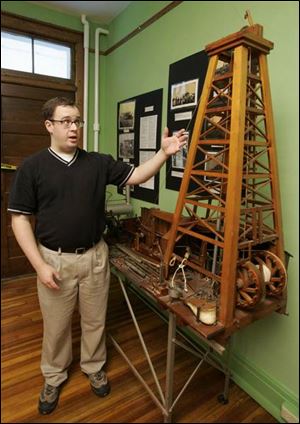
3 area museums showcase region's oil-industry boom
7/16/2006
Randy Brown of the Wood County Historical Center and Museum discusses a model of a rig from the early 1900s.
With gasoline dollars buying a little less with every visit to the filling station, it's hard to believe that there was a time when small-town governments were giving the stuff away.
Three museums in Wood, Hancock, and Allen counties still remember.
They have teamed up to create the Great Oil and Gas Boom Passport Program, running through Sept. 30.
The boom lasted through the last 20 years of the 19th century and was a period of wealth and industrial growth for all three counties.
"We have a shared oil history," said Christie Raber, director of Wood County Historical Center and Museum.
"We decided that if we pulled together to create this program, it would be a wonderful way to work together to get people coming through the doors, to learn what the oil history is all about."
Visitors can request a passport at any of the museums. They'll get a stamp at each exhibit, and after collecting all three, they'll be eligible to win prizes. Nine will be given away at 2 p.m. Oct. 4 at Hancock Historical Museum: three $50 gas cards, three oil-change gift certificates or $20 in cash (winner's choice), and three videos of Ohio Crude, a WBGU-PBS documentary on the boom.
Marathon Oil Company, Valero Lima Refinery, and WBGU-PBS are sponsoring the program.
Paulette Weiser, a curator at Hancock Historical Museum, said that each area has something unique to its history under the larger theme of the oil and gas boom.
Oil was tapped on the site of the Wood County museum. It is the only one of the three with a working oil derrick on the grounds, though it is not original to the site. On July 27 at 7 p.m., the museum will hold a public demonstration of how it works.
Hancock County had the Karg Well, which became the largest producing natural-gas well in the world when it was hit in January, 1886. It produced 10.5 million cubic feet daily.
"There were excursion trains bringing in people just to see all the things that were going on," Ms. Weiser said. "The population quadrupled. Findlay grew from this sleepy little village to this big industrial community."
Back then, there was no end in sight to the wealth generated by the energy source, and city governments were giving oil away to attract businesses to the area.
The stately Victorian houses that remain in many of these cities are a testament to the era's extravagance. In Lima, only two remain, one of which is on the campus of the Allen County Museum. The house was built in 1893 and once was owned by John Van Dyke, John D. Rockefeller's representative in the area.
There's still oil lurking under the Lima Oil Field that stretched from Toledo into Auglaize County and west to Indiana - once the natural gas ran out, it became too expensive to extract what oil was left. Pat Smith, director of Allen County Museum, wondered whether we would see that kind of extravagance again if the oil was tapped.
"Could we see another gas and oil boom in northwest Ohio?" she asked. "How would people react? Does time really change that part of human nature?"
"People were thinking that Cygnet and North Baltimore would be the next Cleveland and Chicago," said Randy Brown, Wood County curator. "There were a lot of riches made, but it ran out quickly."
All the museums agreed it was important to remember this period in Ohio's history. "The more you know about the past, the better you are able to make informed decisions about the future," Ms. Weiser said.
Contact Carin Yavorcik
at: cyavorcik@theblade.com
or 491-724-6050.